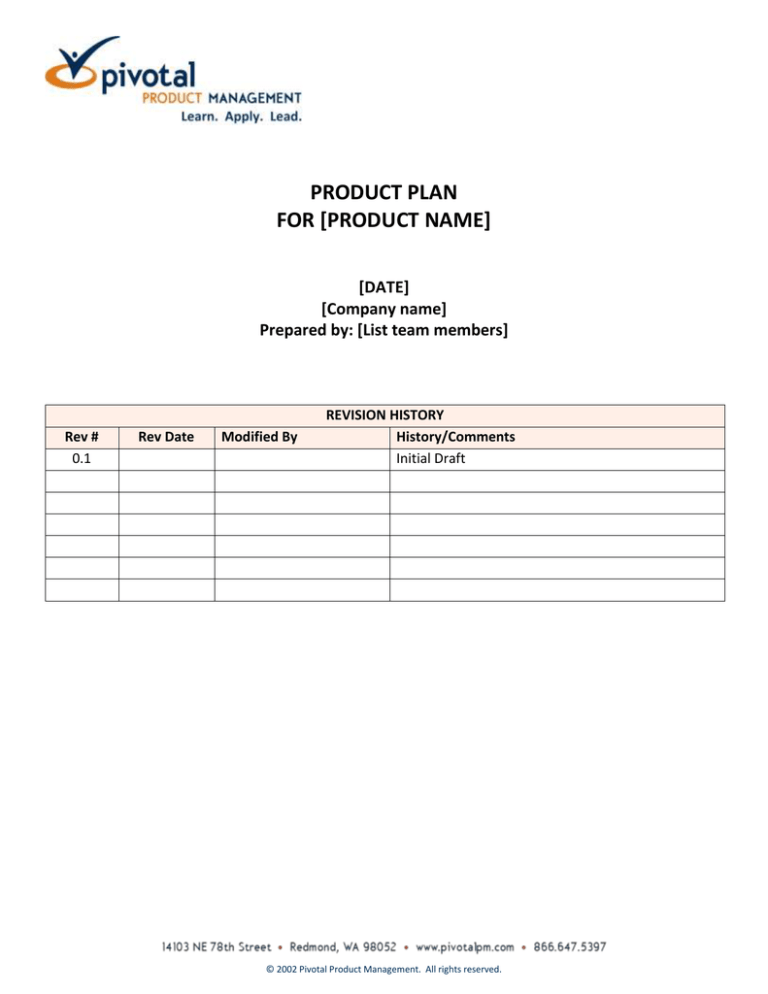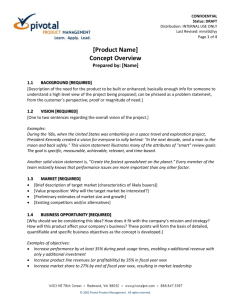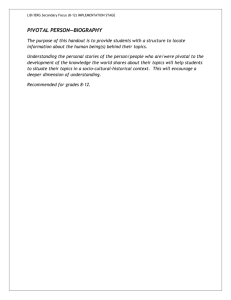
PRODUCT PLAN
FOR [PRODUCT NAME]
[DATE]
[Company name]
Prepared by: [List team members]
Rev #
0.1
Rev Date
Modified By
REVISION HISTORY
History/Comments
Initial Draft
© 2002 Pivotal Product Management. All rights reserved.
1
2
3
4
EXECUTIVE SUMMARY .................................................................................................................................... 4
1.1
OBJECTIVES ............................................................................................................................................... 4
1.2
TARGET CUSTOMERS & MARKET ANALYSIS ............................................................................................. 4
1.3
POSITIONING, VALUE PROPOSITION (BENEFITS) ..................................................................................... 4
1.4
FEATURES ................................................................................................................................................. 4
1.5
SALES & MARKETING STRATEGY .............................................................................................................. 4
1.6
FINANCIAL/BUSINESS CASE ...................................................................................................................... 5
1.7
COMPETITIVE PRODUCTS ......................................................................................................................... 5
1.8
PRODUCT SCHEDULE ................................................................................................................................ 5
PRODUCT DESCRIPTION & POSITIONING STATEMENT................................................................................... 5
2.1
PRODUCT CONCEPT & HISTORY ............................................................................................................... 5
2.2
KEY MESSAGES & MAIN BENEFITS ........................................................................................................... 5
2.3
FEATURES, FUNCTION & BENEFITS .......................................................................................................... 5
TARGET CUSTOMERS ...................................................................................................................................... 6
3.1
FOR PRIMARY CUSTOMERS, IDENTIFY KEY INFLUENCERS, DECISION MAKER, & ECONOMIC BUYER ..... 6
3.2
IDENTIFY SECONDARY CUSTOMER(S) ...................................................................................................... 6
TARGET USERS ................................................................................................................................................ 6
4.1
IDENTIFY PRIMARY USER .......................................................................................................................... 6
4.2
IDENTIFY SECONDARY USER ..................................................................................................................... 7
5
MARKET DATA & ANALYSIS ............................................................................................................................. 7
6
FINANCIAL DATA/BUSINESS MODEL ............................................................................................................... 7
6.1
PRICING .................................................................................................................................................... 7
6.2
FINANCIAL PROJECTIONS ......................................................................................................................... 7
7
SALES & DISTRIBUTION ................................................................................................................................... 8
8
PARTNER PROGRAMS ..................................................................................................................................... 8
9
GO TO MARKET PLAN...................................................................................................................................... 8
10 DEVELOPMENT PLAN OVERVIEW ................................................................................................................... 9
10.1
SCHEDULE: GOLD [MONTH] [DAY], [YEAR]........................................................................................... 9
10.2
STRATEGY.............................................................................................................................................. 9
© 2002 Pivotal Product Management. All rights reserved.
10.3
SYSTEMS DEVELOPMENT: SPECIAL ISSUES ........................................................................................... 9
10.4
QUALITY ASSURANCE RESOURCES ....................................................................................................... 9
10.5
DOCUMENTATION RESOURCES ............................................................................................................ 9
10.6
BETA PROGRAM.................................................................................................................................. 10
11 OPERATIONS PLAN OVERVIEW ..................................................................................................................... 10
11.1
TECH SUPPORT ................................................................................................................................... 10
11.2
CUSTOMER SERVICE ........................................................................................................................... 10
11.3
SALES OPERATIONS ............................................................................................................................ 10
11.4
DATA CENTER/NOC............................................................................................................................. 10
11.5
MANUFACTURING .............................................................................................................................. 10
12 PRODUCT SCHEDULE: MAJOR MILESTONES ................................................................................................ 10
13 PRODUCT TEAM (ROLES & RESPONSIBILITIES) ............................................................................................. 11
14 OPEN ISSUES ................................................................................................................................................. 11
15 COMPETITIVE PRODUCTS & ANALYSIS ......................................................................................................... 11
15.1
OVERVIEW .......................................................................................................................................... 11
15.2
COMPETITIVE STRENGTHS & RESPONSE STATEMENTS ..................................................................... 11
15.3
COMPETITIVE PRODUCTS POSITIONING SUMMARY .......................................................................... 12
15.4
COMPETITIVE PRODUCTS FEATURE SUMMARY ................................................................................. 12
16 PRODUCT FAQ ............................................................................................................................................... 12
© 2002 Pivotal Product Management. All rights reserved.
CORPORATE LIBRARY
Status: DRAFT
Distribution: INTERNAL USE ONLY
Last Revised: mm/dd/yy
Page 4 of 12
1
EXECUTIVE SUMMARY
[Background of problem and vision of solution.]
1.1
OBJECTIVES
[Business objectives for this product (e.g. how much revenue, market share). Other success metrics
that you will track.]
1.2
TARGET CUSTOMERS & MARKET ANALYSIS
[Describe target customers (company size and industry, location if applicable, title and department of
decision makers and users), in priority order; a few key bullets that describe the market expectations
and market drivers.]
For example:
Research shows the following:
Corporate training investments will continue to increase. Corporate expenditures by 1995 will grow
by $100 billion a year.
1.3
POSITIONING, VALUE PROPOSITION (BENEFITS)
Example:
Productivity
Because of its ease-of-use and non-scripting functionality, X will radically increase the productivity of
the content specialist and educator, helping them create CBT materials Y% faster and producing faster
return on investment for training programs.
Unlike scripting-based CBT authoring tools, X uses a WYSIWYG user interface to reduce errors and
rework, and automates many content creation tasks formerly handled via lengthy scripts.
1.4
FEATURES
[Top 5 features in bullet format]
1.5
SALES & MARKETING STRATEGY
[How will you reach the target audience with your messages, and who will they buy from?]
Example:
Customers will buy the product directly from XYZ Co, via its inside telesales group. Leads will be
generated by direct marketing via trade publication subscriber lists and will include trial software with
sample CBT modules on CD. The product will be showcased at where(trade shows, road shows,
conferences, etc.) including demo stations, workshops, and XXX. Traditional collateral will be available,
including a sales guide, data sheet, and inclusion in the family of products brochure.
© 2002 Pivotal Product Management. All rights reserved.
CORPORATE LIBRARY
Status: DRAFT
Distribution: INTERNAL USE ONLY
Last Revised: mm/dd/yy
Page 5 of 12
1.6
FINANCIAL/BUSINESS CASE
Rough estimates show that we could sell into Q at the rate of X per [MONTH/QUARTER/YEAR]. This is a
conservative estimate. At $[PROPOSED PRICE] we would be forecasting approximately $ [REVENUE]
per month. The product is projected to show profitability by [MONTH/QUARTER/YEAR].
1.7
COMPETITIVE PRODUCTS
[A sentence that describes why you’re unique (e.g. cost, platform, etc.). List competitors and price
ranges. The closest competing products functionally would be those list why. Expand on why we’re
special compared to competition.]
1.8
PRODUCT SCHEDULE
The preliminary development schedule has been [ESTIMATED/COMPLETED]. [Describe other schedule
issues, opportunities using no more than a sentence for each department and only critical path
departments or components.]
2
PRODUCT DESCRIPTION & POSITIONING STATEMENT
For [TARGET CUSTOMER] who [STATE THE PROBLEM],
[YOUR COMPANY/PRODUCT] is a [CATEGORY OF PRODUCT OR SERVICE]
that [HIGH LEVEL SOLUTION AND BENEFIT].
Unlike [COMPETITORS/ALTERNATIVES], we [DIFFERENTIATOR].
Competitive Analysis is included at the end of this document.
2.1
PRODUCT CONCEPT & HISTORY
[Paragraph on how this product came into being and what the basic concept or development premises
are.]
Example:
Windows written in C, or this is a quick and dirty implementation to make it to market and needs to be
have follow on plan to fix it upon success in the market as determined by XXX.
2.2
KEY MESSAGES & MAIN BENEFITS
[More description on the key benefit with examples that sales and marketing can use for positioning in
the marketplace and competition.]
2.3
FEATURES, FUNCTION & BENEFITS
FEATURE
Custom menus and tool
bars; context-sensitive
menus.
FUNCTION
Lets users organize menus and tool bars for the
functions they use most often. Menus display
only functions that are enabled.
© 2002 Pivotal Product Management. All rights reserved.
BENEFIT & PROOF
Saves time in learning to use the
product, and in creating training
material. Faster ROI on training
investment.
Independent usability tests
CORPORATE LIBRARY
Status: DRAFT
Distribution: INTERNAL USE ONLY
Last Revised: mm/dd/yy
Page 6 of 12
show that designers can
complete tasks in 15% less time
than with prior version or with
competitors products.
Detailed description of each feature is included in the Market Requirements Document [network
location].
FACT SHEET
Name
Descriptor (Tag Line)
Version
Price
System Requirements
Media
Special Promotions
Ship Date
Online Help & Tutorials
Documentation
3
TARGET CUSTOMERS
3.1
FOR PRIMARY CUSTOMER SEGMENT(S), IDENTIFY KEY INFLUENCERS, DECISION MAKER, &
ECONOMIC BUYER
[Describe who they are, their role in the business, what tasks they will accomplish with this product,
the process they currently use, how this product will change their life and any other important
information about their company, expected plans, etc.]
3.2
IDENTIFY SECONDARY CUSTOMER(S)
[Describe who they are, their role in the business, what tasks they will accomplish with this product,
the process they currently use, how this product will change their life and any other important
information about their company, expected plans, etc.]
4
TARGET USERS
4.1
IDENTIFY PRIMARY USER
[Describe who they are, their role in the business, what tasks they will accomplish with this product,
the process they currently use, how this product will change their life and any other important
information about their company, expected plans, etc.]
© 2002 Pivotal Product Management. All rights reserved.
CORPORATE LIBRARY
Status: DRAFT
Distribution: INTERNAL USE ONLY
Last Revised: mm/dd/yy
Page 7 of 12
4.2
IDENTIFY SECONDARY USER
[Describe who they are, their role in the business, what tasks they will accomplish with this product,
the process they currently use, how this product will change their life and any other important
information about their company, expected plans, etc.]
5
MARKET DATA & ANALYSIS
[This section presents market data that supports the introduction of the product in the current
identified marketplace. This takes each bullet from the executive summary and expands on it with both
narrative and numeric data (cite references). It also includes why the product fits into the market.]
Example:
Corporate training investments will continue to increase.
Corporations will continue to make an investment in corporate training. With the recession and layoffs,
online training will become more important both from a financial and from a resource (people) aspect.
Multimedia software will play a significant role in interactive learning as well as interactive distance
learning, training that takes place with the students and instructor in separate locations that still
retains the kernel of the student/teacher relationship through interactivity. The following data supports
this conclusion:
6
The American Society for Training and Development estimates that corporate training expenditures
by 1995 will grow by $100 billion a year. (Source: Multimedia Applications and Markets—A FiveYear Forecast, Market Vision, 1993, p. 169).
FINANCIAL DATA/BUSINESS MODEL
6.1
PRICING
[Give suggested prices include all bundles, upgrades, competitive offers, etc. Describe how the
proposed prices were determined - one sentence.]
Version Upgrade/Competitive Upgrade Matrix
PRODUCT
RETAIL
INTRO.
COMP.
PRICING
UPGRADE
VERSION
UPGRADE
6.2
FINANCIAL PROJECTIONS
[Describe briefly how the forecast and costs were derived, and assumptions.]
© 2002 Pivotal Product Management. All rights reserved.
PRODUCT TO
PRODUCT
CORPORATE LIBRARY
Status: DRAFT
Distribution: INTERNAL USE ONLY
Last Revised: mm/dd/yy
Page 8 of 12
Unit Forecast
Revenue Forecast
Cost of Goods
Net Revenue
Development Cost
Operations Cost
Marketing & Sales Cost
Net Contribution
PRE-LAUNCH
Period 1
Period 2 [ETC.]
n/a
n/a
n/a
n/a
POST-LAUNCH
Year 1
Year 2
See detailed financial breakdown in [FILENAME].
7
SALES & DISTRIBUTION
[Discuss how each segment of the market will be targeted. Who will sell and why they care about this
product? Discuss channel discounts if applicable.]
8
PARTNER PROGRAMS
[Discuss how each type of partner will be targeted (e.g., systems integrator, technology, outsourcer,
VAR, etc.). Who will sell and why they care about this product? How we will support them? What
training? See Partner Plan Template.]
9
GO TO MARKET PLAN
[Two to three sentences that describe how marketing deliverables and activities will build awareness,
momentum, and revenue for the product.]
Marketing activities to launch and promote the product include:
[List the most likely activities.]
Examples:
[MONTH] Press/industry analyst tour
[MONTH] Sales/channel/partner training
[MONTH] Press release
[MONTH] Webinar series
[MONTH] [NAME OF] tradeshow in [LOCATION]
Corporate partner program and corporate advisory board
[MONTH] beta program (for functionality and usability)
Advertising (as part of family of products strategy)
Direct mailing to the X magazine lists
© 2002 Pivotal Product Management. All rights reserved.
CORPORATE LIBRARY
Status: DRAFT
Distribution: INTERNAL USE ONLY
Last Revised: mm/dd/yy
Page 9 of 12
Marketing deliverables required to launch and promote the product include:
[List the most likely deliverables.]
Examples:
Product brochure
Family brochure
Sales guide
Web-based demo
Hands-on demo
PowerPoint sales presentations
Reviewer’s guide
Direct e-mails
These activities and deliverables will be explained in detail in the Marketing Plan, to be prepared in
conjunction with Marketing Communications, by [DATE].
10
DEVELOPMENT PLAN OVERVIEW
10.1 SCHEDULE: GOLD [MONTH] [DAY], [YEAR]
We project X [DAYS/WEEKS] of development time to implement all functionality followed by a X[DAYS/WEEKS] QA cycle to reach full stability. This yields a Gold date [MONTH] [DAY], [YEAR]. The
feature set remains with the exception of [LIST EVERY EXCEPTION BRIEFLY]. The schedule assumes [list
all assumptions].
10.2 STRATEGY
[This paragraph is the development strategy initial platform, database to be used, language, tools,
process, etc.]
10.3 SYSTEMS DEVELOPMENT: SPECIAL ISSUES
[This is a paragraph for every special issue, such as the high risk areas, expected changes, key new
features that can’t be comfortably estimated etc.]
10.4 QUALITY ASSURANCE RESOURCES
Currently, the plan calls for X tester(s) be assigned to the product. We believe that X testers would be
appropriate during the later stages of development.
10.5 DOCUMENTATION RESOURCES
[UX LEAD] has submitted a documentation plan that includes context-sensitive help and [LIST ALL
COMPONENTS].
© 2002 Pivotal Product Management. All rights reserved.
CORPORATE LIBRARY
Status: DRAFT
Distribution: INTERNAL USE ONLY
Last Revised: mm/dd/yy
Page 10 of 12
10.6 BETA PROGRAM
We should also consider a beta program of X sites selected from [IDENTIFY WHERE AND TYPE OF TEST
SITE]. The purpose of this program would be [LIST KEY OBJECTIVES BY DEPARTMENT IF POSSIBLE].
11
OPERATIONS PLAN OVERVIEW
11.1 TECH SUPPORT
[Overview activities needed to prepare for and supply technical support for the product; when
activities need to begin; what resources are required for preparation and delivery over what period of
time; who is responsible.]
11.2 CUSTOMER SERVICE
[Overview activities needed to prepare for and supply customer service for the product; when
activities need to begin; what resources are required for preparation and delivery over what period of
time; who is responsible.]
11.3 SALES OPERATIONS
[Overview activities needed to take and process orders; when these activities need to begin and be
complete; what information needs to be supplied in order to begin; who is responsible. Pricing and
licensing policies, contracts, channel discount structures, product packaging and configurations (single
user, multiuser, network versions) all need to be decided and implemented.]
11.4 DATA CENTER/NOC
[Overview activities needed to support delivery of the product and/or website; when these activities
need to begin and be complete; what resources are required for preparation and delivery over what
period of time; who is responsible.]
11.5 MANUFACTURING
[Overview activities needed to support manufacturing and shipping of physical components of the
product; when these activities need to begin and be complete; what resources are required for
preparation and delivery over what period of time; who is responsible.]
12
PRODUCT SCHEDULE: MAJOR MILESTONES
Example:
Project approval
Marketing plan complete
Sales/channel plan complete
Pricing and licensing approved
Operations plan complete
Alpha
Beta
User doc and training complete
11/6/12
© 2002 Pivotal Product Management. All rights reserved.
CORPORATE LIBRARY
Status: DRAFT
Distribution: INTERNAL USE ONLY
Last Revised: mm/dd/yy
Page 11 of 12
Sales and tech support training
First customer/marketing demos
Customer service training
Press tour
Gold (RTM, GA)
13
PRODUCT TEAM (ROLES & RESPONSIBILITIES)
[For the exercise, ensure all departments are represented; assign leads from your team]
Example:
14
DEPARTMENT
ASSIGNED
Product Development
User Experience
Marketing Communications
Sales & Sales Ops
Finance
George x123
Lilly x234
James x 345
Marie x456
Samantha x222
OPEN ISSUES
ISSUE
15
DATE
OPENED
RESOLUTION PERSON RESPONSIBLE
NEEDED BY
COMPETITIVE PRODUCTS & ANALYSIS
15.1 OVERVIEW
[Same paragraph from executive summary.]
15.2
COMPETITIVE STRENGTHS & RESPONSE STATEMENTS
Competitor 1 – Strength #1
[Brief description of the strength as positioned by competitor.]
Our response
[Brief response that our sales force would use in a sales situation.]
Competitor 1 – Strength #N
[Brief description of the strength as positioned by competitor.]
Our response
© 2002 Pivotal Product Management. All rights reserved.
CORPORATE LIBRARY
Status: DRAFT
Distribution: INTERNAL USE ONLY
Last Revised: mm/dd/yy
Page 12 of 12
[Brief response that our sales force would use in a sales situation.]
Competitor 2 – Strength #1
[Brief description of the strength as positioned by competitor.]
Our response
[Brief response that our sales force would use in a sales situation.]
Competitor 2 – Strength #N
[Brief description of the strength as positioned by competitor.]
Our response
[Brief response that our sales force would use in a sales situation.]
15.3 COMPETITIVE PRODUCTS POSITIONING SUMMARY
PRODUCT NAME
COMPANY
POSITIONING STATEMENT
15.4
COMPETITIVE PRODUCTS FEATURE SUMMARY
FEATURE
16
PRICING
[OUR
PRODUCT
NAME]
[COMPETITIVE
PRODUCT
NAME]
[COMPETITIVE
PRODUCT
NAME]
[COMPETITIVE
PRODUCT
NAME]
[COMPETITIVE
PRODUCT
NAME]
[COMPETITIVE
PRODUCT
NAME]
PRODUCT FAQ
The following section presents questions and answers about the functionality of the product.
Q.
[Will the product be able to do something?]
A.
[Yes. But it is limited in these specific situations with this workaround. It will be addressed in
more detail when/never.]
Pivotal Product Management provides award-winning product management training, consulting, coaching, and skills assessment.
Please contact us if you have questions about using this tool. Visit our website for more Product Management best practices, free
tools, and templates.
© 2002 Pivotal Product Management. All rights reserved.





